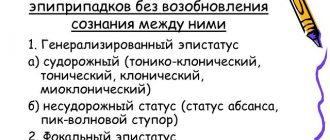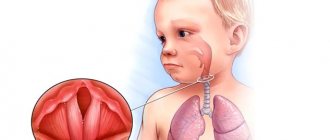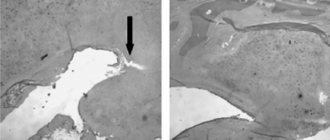Epilepsy is a neurological pathology of a chronic nature. With it, the body is predisposed to convulsive attacks of varying strength.
A typical manifestation of the disease is periodic situations during which muscle cramps develop into a seizure with loss of consciousness.
A child’s brain activity is normalized with pills
Severe seizures are considered an extremely severe variant of epilepsy. Fortunately, it occurs relatively rarely. In newborns and small children, convulsive signs are mild. They are easy to confuse with normal activity or not even notice.
Whether epilepsy in young children and adolescents can be treated or not depends on many factors. First of all, it depends on the cause and aggressiveness of the disease, the characteristics of the body, the therapy prescribed and taken. Doctors say that childhood epilepsy is curable in most cases, but it is necessary to undergo a course of complex therapy.
Types of childhood epilepsy
The following types of seizures are distinguished in children:
- Absence or non-convulsive generalized. A common type, manifests itself from birth to puberty. Difficult to detect, absence lasts 5-20 seconds. The child “switches off” from the world around him. Such attacks may be accompanied by a slight tilting of the head and trembling of the eyelids. With equal probability, after puberty they may disappear or, on the contrary, intensify.
- Absence - rolling of the eyes and trembling of the eyelids
- Infantile spasms appear at 2-3 years of age. Early in the morning after waking up, the body is not completely controlled for several seconds. The baby nods his head, straightens his legs and arms, brings them to his chest, and his torso leans forward.
- Atonic is an externally short-term fainting spell, during which the body completely relaxes and consciousness becomes darkened for a few seconds.
- Full-blown seizures with severe convulsions, loss of orientation in space.
- Night attacks that occur during sleep can be recognized by sleepwalking. As a rule, they go away by the period of growing up on their own without the necessary treatment. Symptoms of childhood epilepsy are often mild, and parents and relatives do not notice the presence of the disease for a long period. The similarity of manifestations with other diseases complicates the diagnosis and prescription of correct treatment. The average age of identification of patients is 5-18 years.
It is possible to determine with certainty whether it is possible to cure epilepsy completely in a teenager or young children or not, and how to do this, only in some of its variants. Those whose causes of development have been established in detail. More often we have to hope for positive dynamics, with the weakening of convulsions and a decrease in seizures.
Causes of the disease
Possible causes of epilepsy include the following:
- genetic predisposition inherited from parents;
- infectious diseases of the brain;
- traumatic brain injuries;
- viral diseases affecting the brain;
- Down syndrome;
- congenital defects of brain structure;
- chronic diseases of the central nervous system.
The causes of the disease are determined during an examination of the body. Each case is individual and requires a professional approach. Manifestations of the disease can be varied, so it is necessary to take into account any deviations from the norm of the child’s behavior, viral diseases he has suffered, and hereditary factors.
Diagnostics
If you suspect small, insignificant attacks, manifested in the form of short-term freezing or sleepwalking at night, you need to contact a pediatrician, neurologist and conduct a thorough study, since such symptoms are characteristic of a number of diseases.
There is only one way to prove that a patient has epilepsy - EEG (electroencephalography). The results of the study will show specific abnormalities in the functioning of neurons leading to seizures.
When the diagnosis of a seizure disorder is confirmed, the neurologist prescribes additional studies. This is necessary to find out the location and number of foci, the systematic nature of their awakening:
- computed tomography (CT);
- magnetic resonance imaging (MRI);
- video-EEG monitoring.
After studying the results of the study, the type of pathology is specified and complex treatment is prescribed.
How can we help
The neuro-rehabilitation center employs qualified specialists who are ready to provide professional assistance to every child. Since epilepsy is often accompanied by delays in general development and cognitive impairment, we recommend that you undergo a comprehensive examination and rule out possible developmental problems.
We strive to ensure that every child, after completing a course of therapy, can develop fully, does not experience psychological problems, and can study in a regular school.
Our center provides all the conditions to make children and parents feel comfortable:
- homely atmosphere and warm welcome;
- individual approach to each patient;
- modern medical equipment for diagnosis and correction of neurological disorders;
- complete confidentiality;
- individual correction program.
Treatment
After a thorough examination, diagnosis, and clarification of all associated factors, the pediatrician will not be able to accurately answer the question: “Is epilepsy in a child curable or not?” Since it is impossible to eliminate the focus that causes it in the brain. But the chances of stopping the seizures, given the statistics, are not bad.
The neurologist prescribes complex treatment, including:
- drug anticonvulsant therapy;
- optimization of the daily routine;
- organization of special meals;
- bioresonance therapy;
- exposure of the brain to a magnetic field, vortex fields;
- Exercise therapy (physical therapy).
- Anticonvulsants are the basis for the treatment of epilepsy in children
Drugs and dosage are selected specifically for each patient. Since, due to the characteristics of the body, it is impossible to predict the severity of the effects of certain tablets in advance.
In each specific case, the treatment paradigm is selected taking into account the characteristics of the disease and the characteristics of the patient.
Disease prognosis
The disease can have different forms and nature. Short-term seizures do not damage brain cells, unlike long-term seizures, which can cause the death of nerve cells in the brain. Sudden loss of consciousness has a negative impact on the child's health, which can lead to injuries and accidents.
As the disease develops, the child may experience psychological problems - he may begin to fear seizures, which may result in panic attacks.
Prevention
The prevention of seizures plays a special role in getting rid of the disease. However, even if the attacks disappeared from a person’s life a year ago, the foci that caused them do not disappear. Therefore, a diagnosis made in childhood, overcome by painstaking treatment or due to age, can return. In adulthood, with much more serious symptoms.
To reduce the likelihood of this happening, you need to remember throughout your life that your body is prone to seizures. And carry out preventive measures:
- adhere to a clear daily routine;
- avoid discos and computer games;
- choose sports activities allowed for such a diagnosis;
- avoid overwork;
- do not drink alcohol;
- follow a diet;
- avoid taking drugs;
- warn doctors about a previously made diagnosis when choosing medications;
- approach the issue of driving with caution;
- choose a profession taking into account instability to severe stress and overwork; there are jobs that are contraindicated for epileptics;
- closely monitor your health, as some diseases can provoke repeated attacks in adulthood;
- regularly practice courses of selected physiotherapy.
Even if there were no attacks after reaching puberty, and the diagnosis was eventually removed, you cannot forget about the structural features of your brain. Whether it is possible to cure epilepsy in a child forever is an open question due to the specifics of the disease.
First aid during a seizure
During an epileptic attack, it is important not to get confused and take all necessary measures to prevent injury. The child must be placed on a flat, not hard surface. To prevent your baby from choking on saliva, be sure to lay him on his side. If the mouth opens during a seizure, a handkerchief should be placed between the teeth without restricting the child's breathing.
It is strictly forbidden to forcefully open your mouth or hold your tongue. Also, you should not give medication to the patient during a seizure. The attack usually lasts no more than 5 minutes. After the seizure stops, it is necessary to check the baby’s breathing, and, if it is absent, perform artificial respiration. Be sure to wait for the child to come to his senses, do not leave him alone.
If the seizure occurred for the first time or lasted more than 5 minutes, or if the child was injured during the seizure, it is recommended to call an ambulance.
Signs of epilepsy in a child
Epilepsy is a chronic neurological disease that can be caused by genetic predisposition or external factors.
The disease manifests itself approximately equally in both adults and children. However, in the latter it is more difficult to diagnose, because the child’s behavior is often more dynamic, which is associated with the normal physical activity of the growing organism. The main signs of childhood epilepsy:
1. Seizures . Can last from 10 seconds to 20 minutes. Characterized by tension in all muscle groups and trembling. In this case, there is a short-term cessation of breathing at the very beginning of the attack. The bladder often empties spontaneously. Upon completion of the attack, the child usually immediately falls asleep;
2. Absence seizures are seizures without convulsions. In such situations, the child becomes as if protected from the world. There is a blank look in the eyes. He does not respond to movements, light, or sounds. It is almost impossible to attract the baby's attention during such an attack, which lasts up to half a minute. Sometimes the eyelids tremble or the head falls back.
3. Attacks of atony . They are characterized by a sharp deterioration in the performance of the central nervous system, as a result of which consciousness is lost and all muscles relax. A standard attack is identical to fainting. Therefore, if the regular loss of a creature by a baby without good reason becomes commonplace, you should consult a doctor;
4. Spasms are involuntary muscle tension. They usually occur in children immediately after sleep. They are manifested by bringing the arms to the chest, bending the torso and head forward, straining and straightening the legs.
What does an EEG look like for epilepsy?
To obtain accurate EEG readings for epilepsy, it is necessary to prepare the patient for the procedure. You need to wash your hair thoroughly to keep your hair clean. Installation fixing agents are not allowed. This will allow you to get closer contact with the scalp. It is not recommended to eat two hours before the procedure, but also not to feel hungry. You should also remove all jewelry before the procedure.
Signs of epilepsy with EEG
EEG in epilepsy helps to identify foci of neuronal activity. EEG indicators determine the form of pathology. They can also be used to track dynamics and determine the dosage of medications. The greatest value of this method is that painful changes can be identified in the intervals between attacks.
The following types of EEG are distinguished:
- routine electroencephalography. Diagnostics, in which the recording and recording of brain biopotentials is carried out to determine epilepsy;
- using additional electrodes;
- during night sleep. EEG indicators are recorded during night sleep;
- long-term EEG in epilepsy. Recording indicators during the day;
- EEG with standard activation procedures. Hyperventilation, photostimulation and the use of other types of stimulation such as reading, watching movies, music;
- video monitoring;
- sleep deprivation procedure.
Quite often, changes in the EEG occur when eye movements, changes in breathing rhythm, vascular pulsation or motor reflexes. Therefore, it is very important to correctly interpret the signs of epilepsy in the EEG.
Forecast
The prognosis for epilepsy if you follow medical recommendations and take medications in a timely manner is favorable. To do this, it is important for a person to maintain a careful attitude towards his health: maintain a daily routine, have adequate sleep, avoid overexertion, and completely give up bad habits such as cigarettes and alcohol.
In most clinics, patients with epilepsy are seen by neurologists or psychotherapists, who sometimes find it difficult to understand the details of diagnosis and the intricacies of treatment of this disease. Just one EEG requires enormous experience and skills of a professional. Therefore, the Yusupov Hospital employs highly specialized epileptologists who can answer all your questions. You can make an appointment with them by calling the Yusupov Hospital.









